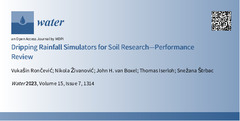Prikaz osnovnih podataka o dokumentu
Dripping Rainfall Simulators for Soil Research - Performance Review
| dc.creator | Rončević, Vukašin | |
| dc.creator | Živanović, Nikola | |
| dc.creator | van Boxel, John | |
| dc.creator | Iserloh, Thomas | |
| dc.creator | Štrbac, Snežana | |
| dc.date.accessioned | 2023-09-21T13:54:16Z | |
| dc.date.available | 2023-09-21T13:54:16Z | |
| dc.date.issued | 2023 | |
| dc.identifier.issn | 2073-4441 | |
| dc.identifier.uri | https://cer.ihtm.bg.ac.rs/handle/123456789/6627 | |
| dc.description.abstract | Rainfall simulators represent often-used equipment for soil research. Depending on their performance, they could be appropriate for some soil research or not. The aim of this research is to provide insight into the capabilities of existing dripping rainfall simulators (DRS) to mimic natural rainfall and the frequency of simulated rainfalls of certain characteristics, facilitate the selection of rain simulators that would best meet the needs of soil research and to reach a step closer to the standardization of rainfall simulators. DRS performance was analyzed integrally, for simulators with more than one dripper (DRS>1) and with one dripper (DRS=1). A statistical analysis was performed for the performance of the DRS, wetted area, drop size, rainfall intensity, duration and kinetic energy. The analysis showed that DRS can provide rainfall that corresponds to natural rainfall, except in terms of the drop size distribution and wetted area. However, usually there are more factors that do not correspond to natural rainfall, such as the median drop size, volume and kinetic energy. Metal and plastic tubes (MT and PT) as the most present dripper types showed a strong relation between the outer diameter (OD) and drop size, while the inner diameter (ID) relation was moderate-to-weak. However, when increasing the range of MT drippers, for diameter size, the relation significance becomes very strong for bouts ID and OD. With the increase in the ID of PT, the relation deviates from the logarithmic curve that represents all drippers together. The sizes of the drops generated by the drippers are mostly in the range between 2 and 6 mm, while the number of drops smaller than 2 mm is relatively small. The intensity and duration of the simulated rain can be successfully produced to match natural values, with the most frequently simulated short-term rainfall of a high intensity. Most simulations were conducted at a fall height of up to 2 m, and then their number gradually decreases as the height gets closer to 5 m. Most simulations (58.6%) occur in the range between 20-90% KE, then 33.0% in a range of 90-100%, with only 8.4% lower than 20% KE. | sr |
| dc.language.iso | en | sr |
| dc.publisher | MDPI | sr |
| dc.relation | info:eu-repo/grantAgreement/MESTD/inst-2020/200026/RS// | sr |
| dc.relation | info:eu-repo/grantAgreement/MESTD/inst-2020/200169/RS// | sr |
| dc.relation.isreferencedby | https://cer.ihtm.bg.ac.rs/handle/123456789/7326 | |
| dc.rights | openAccess | sr |
| dc.rights.uri | https://creativecommons.org/licenses/by/4.0/ | |
| dc.source | Water | sr |
| dc.subject | dripping rainfall simulators | sr |
| dc.subject | drippers | sr |
| dc.subject | simulator performance | sr |
| dc.subject | soil research | sr |
| dc.subject | rainfall simulator review | sr |
| dc.title | Dripping Rainfall Simulators for Soil Research - Performance Review | sr |
| dc.type | article | sr |
| dc.rights.license | BY | sr |
| dc.citation.volume | 15 | |
| dc.citation.issue | 7 | |
| dc.citation.spage | 1314 | |
| dc.citation.rank | M22~ | |
| dc.description.other | Encyclopedia Platform entry baseed on this article: [https://cer.ihtm.bg.ac.rs/handle/123456789/7326] | |
| dc.identifier.doi | 10.3390/w15071314 | |
| dc.identifier.fulltext | http://cer.ihtm.bg.ac.rs/bitstream/id/26947/bitstream_26947.pdf | |
| dc.identifier.scopus | 2-s2.0-85152860716 | |
| dc.identifier.wos | 000970241600001 | |
| dc.type.version | publishedVersion | sr |


